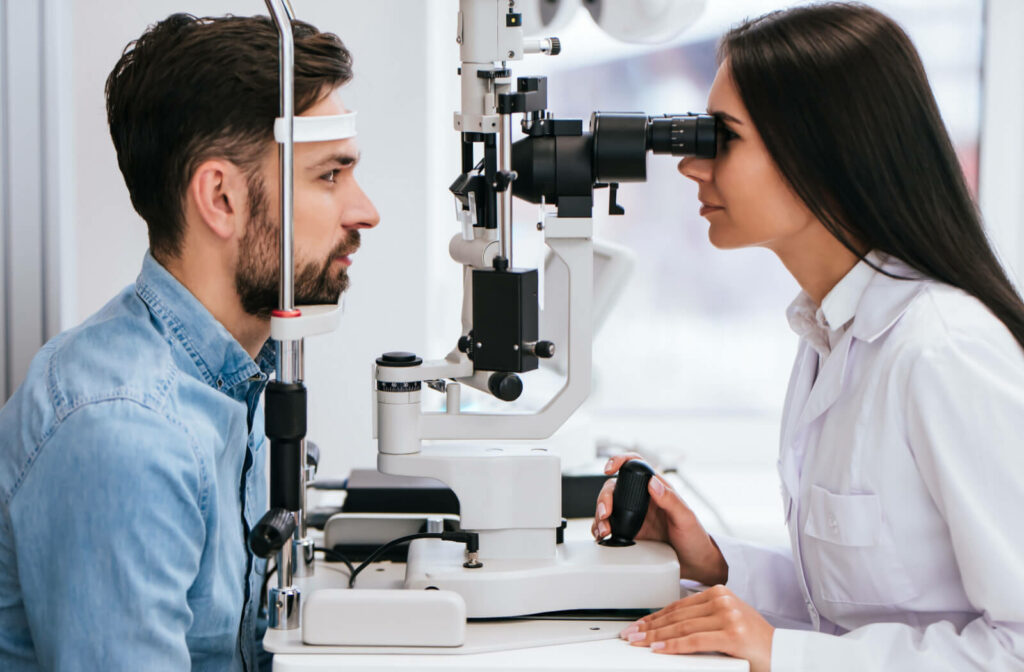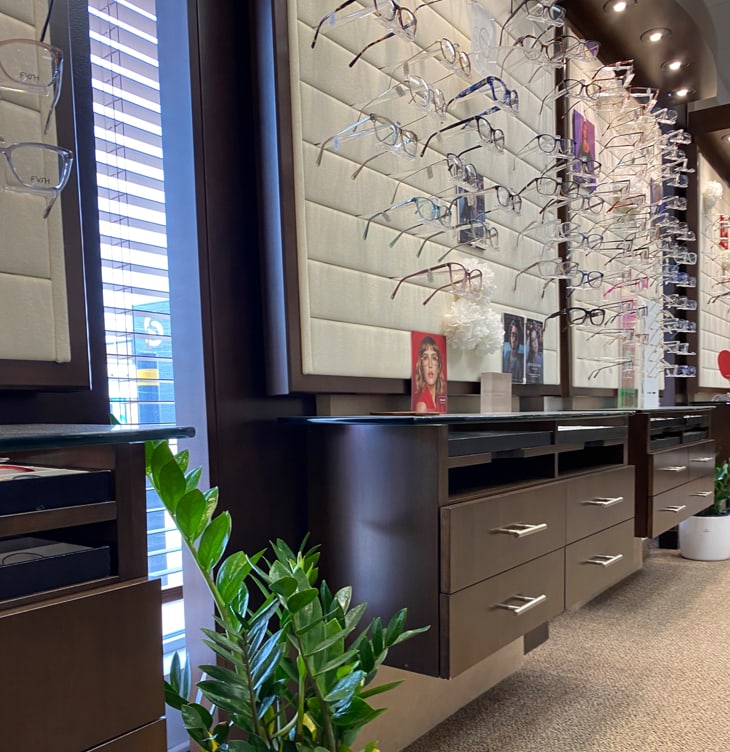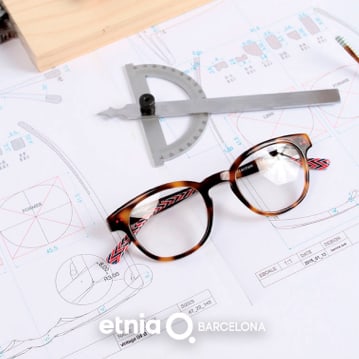One of the best ways to protect your eye’s long-term health is with regular comprehensive eye exams. A comprehensive eye exam allows an optometrist to look at your entire eye and visual system, allowing them to diagnose various eye diseases and disorders.
These exams involve tests designed to detect early signs of eye disease, such as glaucoma, cataracts, and macular degeneration. The earlier these signs are noticed, the earlier your optometrist can begin offering treatment or management plans that may slow their progression.
During Your Comprehensive Eye Exam
The tests you’ll receive during a comprehensive eye exam depend on your eye health needs. Your optometrist will go over your medical history and decide what the areas of concern are. For example, if you have a family history of glaucoma, you may get tested for it earlier than others might. Your optometrist won’t take any shortcuts in helping you protect your vision.
A comprehensive eye exam typically takes between 30–60 minutes, depending on the amount of testing you need.
Sight Tests vs. Comprehensive Eye Exams
Many schoolchildren go through a sight test, which may be confused with a comprehensive eye exam. A sight test measures your lens power using a combination of computerized and automated tests. While these tests may uncover signs of a vision problem, they’re typically not performed by a trained vision professional and only give a basic understanding of your visual health.
Seeing something is more than having 20/20 vision. Vision means being able to take what your eyes see and process it into something you can understand. You may have perfect vision according to a sight test but still struggle to see things clearly.
Additionally, a sight test may overlook serious eye health problems hiding inside your eye. A comprehensive eye exam includes a sight test performed by a trained optometrist but can also offer a complete overview of your current vision health.
Visual Acuity
A visual acuity test measures how well you can see with each eye. Your optometrist may ask you to cover one eye and identify a series of symbols, typically numbers or letters. These symbols are different sizes, and as you identify them, your optometrist is able to determine how well you can see at various distances.
Refraction Tests
A refraction test is used by an optometrist to accurately figure out your prescription by measuring how light reflects off your retina, the layer of cells on the back of your eye. During this test, your optometrist will shine a light into each of your eyes, typically using an autorefractor. This instrument then measures the amount of light reflecting off your retina. This part is called an objective refraction, as it is only based on the physical characteristics of your eyes and on optic principles.
Since a healthy eye refracts light through the cornea and the lens, an error in the light reflecting off the retina is called a refractive error.
Afterward, your optometrist will do a subjective refraction and have you look through lenses of different strengths. They will then have you read numbers or letters off of a chart while switching the lenses in front of each eye. As you tell your optometrist which lens gives you the clearest vision, they’re able to determine the eyeglass lenses that will hopefully give you vision as close to 20/20 as possible. Don’t worry if you don’t trust yourself with “1” or “2”, an experienced clinician is able to finalize the prescription using both objective and subjective data combined.

Internal Eye Health
The main thing a comprehensive eye exam gives you that sight tests can’t is a look inside your eyes. Some eye diseases begin to show signs before you’ll notice the symptoms. Your optometrist might use a slit lamp to peer into the back of your eyes, inspecting your retina, your optic nerve and blood vessels.
This test can even uncover signs of many vascular conditions including high blood pressure or diabetes, or many systemic conditions including autoimmune diseases and brain lesions.
Ocular Motility & Binocular Vision Assessment
Binocular vision is the ability to see using both eyes together. To see a clear image, your eyes must work together to focus and move. This assessment can recognize if you have a problem moving your eyes in unison, which could result in conditions such as double vision.
Your optometrist will check to see if your eyes move together and, if they’re not, work to figure out why. This can be caused by any one of your 6 eye muscles weakening, and it can also be caused by a lack of communication from the nerves. Knowing the source of the problem is essential in finding a treatment.
Glaucoma Screening
Glaucoma is one of the leading causes of blindness in Canada, caused by damage to the optic nerve gradually affecting peripheral vision, typically when pressure increases in your eye. However, don’t be fooled by thinking glaucoma is “pressure in your eyes”, as you may still have glaucoma even with normal eye pressure. A visual field test is needed to diagnose glaucoma however, with the development of advanced technology, the use of optical coherence tomography (OCT) of the optic nerve and the retina became rapidly the standard of care to detect, screen and monitor glaucoma, alongside a fundus examination. During a comprehensive eye examination, we will assess all your risks factors associated with glaucoma, based on your family and very own medical history, your lifestyle, the anatomy and the physiology of your eyes; from there, our Doctors of Optometry will be able to recommend a management plan to screen and track the development of glaucoma.
The most common test for glaucoma, however, is done by testing the pressure in your eye. For many types of glaucoma, an increase of pressure is measurable in the early stages. This test is done by measuring the force needed to flatten your cornea. Whether this is done with a small, blunt probe or a puff of air is determined by your optometrist.
Additional Vision Tests
Your optometrist will use your vision and medical history to decide which tests to perform, and you may undergo additional tests if necessary. Some may be necessary depending on the results of previous tests, while others may be done if you indicate a specific issue.
At Old South Optometry, we focus on the use of advanced eye care technology for the early diagnosis of many eye conditions, including myopia, corneal diseases (keratoconus), glaucoma, macular degeneration, diabetic retinopathy and macular edema. We have on-site diagnostic instruments allowing OCT imaging, ultra-wide field retinal imaging, corneal topography and ocular biometry (axial length measurements). We also have access to fundus auto-fluorescence technology that allow our optometrists to see change in the retinal cells activity, which can highlight undergoing disease prior any physical visible changes, really useful for Plaquenil (hydroxychloroquine) toxicity screening, and assessing risk of fast progression of macular degeneration per example.
Keep track of any vision problems you notice through your daily routines so your optometrist can give you the best care possible.
How Often Should You Have an Eye Exam?
According to the Canadian Association of Optometrists, infants should have their first eye exam between 6–9 months. Children should then have another exam between 3-5 years old, then receive exams based on their eye doctor’s recommendations until they’re 19.
Adults should follow these guidelines:
- 20-39 years: 1 exam every 2–3 years
- 40-64 years: 1 exam every 2 years
- 65+ years: 1 exam every 18 months
Eye Care Designed for You
A comprehensive eye exam is about more than how well you can see. Old South Optometry has experienced optometrists ready to help you understand your overall eye and vision health.
If you’re ready for your next check-up, or have a vision problem you’re concerned about, book an appointment with us and experience comprehensive care.











